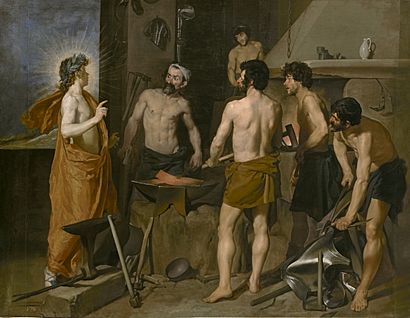Apollo in the Forge of Vulcan facts for kids
Quick facts for kids Apollo in the Forge of Vulcan |
|
|---|---|
 |
|
| Artist | Diego Velázquez |
| Year | 1630 |
| Medium | Oil on canvas |
| Movement | Baroque |
| Dimensions | 223 cm × 290 cm (87+3⁄4 in × 114+1⁄8 in) |
| Location | Museo del Prado, Madrid, Spain |
Apollo in the Forge of Vulcan (Spanish: Apolo en la Fragua de Vulcano), sometimes referred to as Vulcan's Forge, is an oil painting by Diego de Velázquez completed after his first visit to Italy in 1629. Critics agree that the work should be dated to 1630, the same year as his companion painting Joseph's Tunic. It appears that neither of the two paintings were commissioned by the king, although both became part of the royal collections within a short time. The painting became part of the collection of the Museo del Prado, in Madrid, in 1819.
Apollo in the Forge of Vulcan has been cited as one of the most important works from Velázquez's first trip to Italy and "one of his most successful compositions with regard to the unified, natural interaction of the figures."
Subject
The painting depicts the moment when the god Apollo, identifiable by the crown of laurel on his head, visits Vulcan, who is found making weapons for war. The god Apollo tells Vulcan that his wife, Venus, is ... with Mars, the god of war. For this reason, the other figures in the room are looking in surprise at the god who has just appeared before them, some of them even opening their mouths to indicate surprise.
Velázquez was inspired to create this work by an engraving by Antonio Tempesta, modifying it greatly and centering the narrative action on the arrival of Apollo, using a classical baroque style. ..... The frieze-style method of composition could also come from Reni. On the other hand, the clear shades of the figure of Apollo are reminiscent of Guercino.
This work was created in Rome without commission at the request of the painter Peter Paul Rubens who had also visited Spain in 1629. Velázquez painted two large canvases in the house of the Spanish ambassador. These two canvases formed a pair and were brought back to Spain with his luggage: Joseph's Tunic and Apollo in the Forge of Vulcan.
Painting materials
Part of pigments used by Velázquez in this painting have changed their colours so the canvas lost its original color balance. The wreath of Apollo was originally painted green by mixing (blue) azurite, yellow lake and yellow ochre. The lake pigment is not very stable and so the present color of the wreath is almost blue. The color of the loin cloths changed to flat dark brown while the flesh colour mainly containing yellow ochre, vermilion and azurite remained unchanged.
See also
 In Spanish: La fragua de Vulcano para niños
In Spanish: La fragua de Vulcano para niños
- List of works by Diego Velázquez

